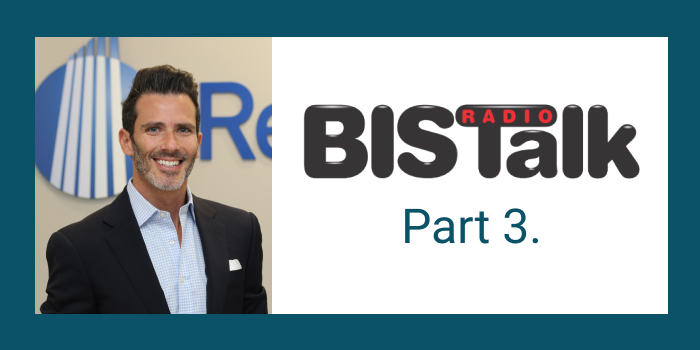This is final part in a three-series interview where CEO of Reliant Funding, Adam Stettner sits down to talk with BISTalk radio host Bob Ryan and co-host, Montana Smit and color commentator Aaron Cannata. The show focuses on delivering useful financial and business information. They invited Adam on air to discuss Reliant Funding and how the company helps underbanked small business owners.
In this part of the series, Adam breaks down the model of lending to businesses even further and explains the logic behind the repayment methodology Reliant uses.
Did you miss part one and two?
MONTANA: Welcome back. You’re listening to BISTalk, believing is seeing talk radio. Tomorrow, our in-studio guest will be Jimmy Tous with Tous Law and Seth Au with Dorado Financial. I’m Montana Smit.
AARON: I’m Aaron Cannata.
BOB: And I’m Bob Ryan. We’re glad you’re with us for our last segment today. We’ve got Adam Stettner in. Reliant Funding is the name of his company. If you’re in business, it might be something worth checking out. Reliantfunding.com. Adam, thanks again for being here.
ADAM: And thank you again for having me.
BOB: We’re talking about your model of lending which I find it really enticing to look at because of the way you’ve broken it down into daily payments back and taking some of the pressure off. Plus, some of the business owners that couldn’t get money at a bank might be able to get it through Reliant Funding and solve some of their problems or grow their business better or more quickly or whatever. We were just talking about the ACH agreement that you have where you are able to deduct the payment back on a daily basis for the exact amount that’s agreed upon ahead of time. So it’s not like you have free reign to their bank account.
ADAM: No, by no means. And when you think about it, a traditional bank loan, you have this big monthly payment. We want to be very different from banks. So I’m sure we all have experience with banks. Your listeners have experience with banks. It’s usually not the most pleasurable; it’s a very transactional environment and it’s often not relationship based.
BOB: I think it costs you $5 to talk to a loan officer now.
ADAM: Right. It might, it might.
BOB: That was a joke. That’s not necessarily –
AARON: It could be.
ADAM: It certainly costs you, in most every way, to use the bank. And the idea here is to create a relationship with small business owners so they know they have a renewable source for capital and the repayment methodology works for them. And I mentioned earlier, if it doesn’t work for them, it certainly isn’t going to work for us. We talked a little bit about the lack of collateral and so it was really important to us that we provide service, relationship, and a payment structure that would have people, at a minimum, paying us back in full. But the hope is that we create a relationship and they come back to us each time they have a need for funding.
BOB: You said you’ve done almost a billion or over –
ADAM: We are just over a billion.
BOB: Where did all that money come from? Did you fund it personally?
ADAM: No, that would be pretty amazing. You are all very nice but I probably wouldn’t be sitting here speaking to you if I was funding this myself.
BOB: Yeah, I would guess.
AARON: You’d be surprised who we get on here.
BOB: Well, that’s a good point.
ADAM: So, no. We actually lever our ability to borrow where – and the irony being oftentimes the businesses that are underbanked, in aggregate when you look at, we are working with tens of thousands of businesses. And so for the banks that we work with, they are dealing with me and one entity and then I in turn am able to –
BOB: So essentially, the banks that would turn down your customers are borrowing from that bank, through you? Well, not from that bank but they’re borrowing money that you’ve leveraged from that bank, then.
ADAM: I would say it’s an ironic arrangement.
AARON: You said something really fascinating over the break; that you don’t consider yourself technically a lender; you consider it a purchase of future cash flows.
ADAM: That’s correct. It’s again, the concept of advancing money to a business – remember, there is no pledged collateral. There’s no personal guarantee other than fraud and so the construct of making something a loan would only tie down the business owner more. So by structuring it as a sale/purchase, again, the sale of future receivables or the purchase of future receivables, it removes the necessity for either pledged collateral or personal guarantee, which again, is more free for the small business owner. And what we’ve found, because I come from a background in finance and/or manufacturing, and what we’ve found is the performance of a portfolio is in line whether you have the guarantee or not. People are either able to repay or they’re not. Bogging them down with collateral and personal guarantees and those kinds of things doesn’t really make a portfolio perform better. So why constrain? Small business owners are constrained enough already. Why constrain them more?
BOB: It’s a really good point. So is the money they are getting through Reliant, going to be competitive in the marketplace, in terms of cost for them since it – it seems like you’re a little bit more astute at making the loans to people. Does that cost more for them or is it a different market weight? In other words, how do you make money off the loans you make?
ADAM: No, it’s a very fair question. What I would say is, our money is more expensive than traditional bank loans.
BOB: It would have to be if you are getting money from banks to re-loan out. So you have to have that spread in there, right?
ADAM: In essence, yes. But at the same time, there is scale to what we do. So our ability to obtain the money, given the scale of what we’re doing, gives us an ability to create margin as well. But at the same time, we do have higher default than traditional bank loans.
BOB: So you have to have a higher rate to cover them?
ADAM: Correct. And candidly, that’s our biggest cost, default. And without a personal guarantee and pledged collateral, you’ve got – I mean, our number one defense is against fraud.
AARON: You have to price that in though.
ADAM: Well, yes but we’re pretty astute and we use a lot of technology on the back end with the intent of identifying fraud. And as long as you remove the fraud, then your default rates come in line. Still above banks but in line.
BOB: Seriously? So fraud is a part of that, then?
ADAM: Well, yeah.
BOB: I guess a part of any borrowing, banking system, right?
ADAM: It’s a part of our lives every day.
BOB: It’s just not something you think of being a factor in the loan rates that you do. You think about maybe defaults but not so much fraud.
ADAM: Correct. Well, no different, candidly, than insurance. All of us with our cars and with everything else.
BOB: That’s a good point. Insurance fraud is not talked about a lot but that makes up a portion of our premiums every time we make a payment.
AARON: So the banks are obviously making a little bit off this too, by lending you the money that you are re-lending. Do you have relationships with them where as if someone were to go in for a loan, get refused, do they say, hey, maybe you want to check out Reliant Funding, they will do things that we aren’t willing to do?
ADAM: So there are some banks that are just starting to look at what I consider alternative financing, which is what I really think is what we are, as a secondary option. And it’s just really beginning. So I think we are at the beginning phase of that occurrence.
BOB: The bank doesn’t have much incentive to refer a client to you other than they can serve that client and that client can still get money even though it’s not through them. Do they get reimbursed if they refer?
ADAM: No, so in the regard, we’re not actively working with banks for turndowns. Our method of acquisition is marketing and referral, at this stage. But in the beginning, it was marketing.
BOB: How long have you been doing this?
ADAM: We started in 2008 with just two people, outbound calling to businesses to see, do you need money. And if you think back to ‘08, the world was on fire from a financial perspective.
BOB: Right. Everybody needed money back then, right?
ADAM: And banks were collapsing. But really you find, small business owners are very wise with how the borrow and how the spend. And so while everybody needed money, people didn’t want to borrow unless they believed they could repay it. Even though your business is struggling, do you want to take on what feels like X amount of dollars of debt when you’re already feeling rather tight? But in a way, we started with two people. We’ve got approximately 150 now; half the group in New York and half the group in San Diego. We started here in San Diego. Amazing people doing incredible things.
BOB: Why New York? Isn’t New York a horribly consumer oriented state to do business in?
ADAM: Remember, we are funding nationwide.
BOB: Oh, that’s right, you’re nationwide. So it’s not necessarily the New York area.
ADAM: Correct.
BOB: So you have a lot going on with this. The future of interest rates has to be on your mind a little bit. Do you see them going up, as we kind of wrap up the show here? Do you see them rising anytime soon?
ADAM: I do. I think it will be slow and steady. And we’ve had a few fed rate increases already.
BOB: Does that affect what you do significantly?
ADAM: It does. I wouldn’t say significantly.
BOB: But enough to make a move on the needle.
ADAM: Those rates pass through to us just like they do to consumers.
BOB: Adam Stettner, thank you so much. Reliantfunding.com is the website. We appreciate you being here. Good luck with this. It sounds like a great model. You’re listening to BISTalk, believing is seeing talk radio. I’m Bob Ryan.
MONTANA: I’m Montana Smit.
AARON: And I’m Aaron Cannata.
BOB: You folks have a great and prosperous day. Bye-bye.
This is the end of the three-part series interview with BISTalk Radio.







